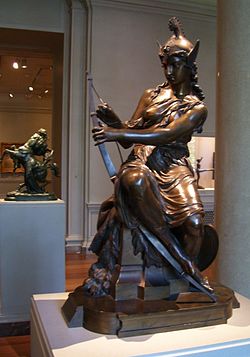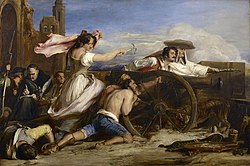This article needs additional citations for verification .(December 2012) |



This is a list of women who engaged in war, found throughout mythology and folklore, studied in fields such as literature, sociology, psychology, anthropology, film studies, cultural studies, and women's studies. A mythological figure does not always mean a fictional one, but rather, someone of whom stories have been told that have entered the cultural heritage of a people. Some women warriors are documented in the written or scientific record [1] [2] and as such form part of history (e.g. the Ancient Briton queen Boudica, who led the Iceni into battle against the Romans). However, to be considered a warrior, the woman in question must have belonged to some sort of military, be it recognized, like an organized army, or unrecognized, like revolutionaries.
Contents
- Pirates and seafarers
- Africa
- Angola
- Benin history
- Berber history
- Burkina Faso
- Egypt
- Kongo
- Somalia
- Ethiopia
- Ghana (then Gold Coast)
- Hausa history
- Yoruba mythology and history
- Nubia/Kush (Sudanese) history
- Americas
- Native Americans
- American Civil War
- American Old West
- American Revolution
- Mexican Revolution
- Argentina – Bolivia
- Brazil
- East Asia
- Historical Mongolia
- Historical China
- Historical Japan
- Korea
- Southeast Asia
- Historical Indonesia
- Historical Malaysia
- Historical Philippines
- Historical Thailand
- Historical Vietnam
- Europe
- Britons, Roman Britain, and history of Anglo-Saxon England
- Celtic mythology and Irish mythology
- Historical Czech Lands
- England
- Duchy of Brittany
- Illyria
- The Netherlands
- Albania
- Historical France
- Greek mythology
- Historical Republic of Poland and Grand Duchy of Lithuania
- Portuguese legend
- Italian history, folklore and Roman mythology
- Russia
- Serbia
- Scandinavian folklore and Germanic paganism
- Spain
- West Asia
- Antiquity Arabia
- Islamic Arabia
- Mesopotamian mythology
- Jewish History
- Persian mythology and history of Iran/historical Persia
- Phoenician mythology
- Israel and Jewish diaspora
- South Asia
- Hinduism Mythology
- Central Asia
- Afghanistan
- See also
- References
- Further reading








